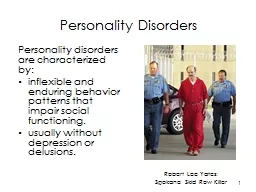

inflexible and enduring behavior patterns that impair social functioning usually without depression or delusions Robert Lee Yates Spokane Skid Row Killer Personality Disorders Broken down into Clusters ID: 909067
Download Presentation The PPT/PDF document "1 Personality Disorders Personality diso..." is the property of its rightful owner. Permission is granted to download and print the materials on this web site for personal, non-commercial use only, and to display it on your personal computer provided you do not modify the materials and that you retain all copyright notices contained in the materials. By downloading content from our website, you accept the terms of this agreement.
Slide1
1
Personality Disorders
Personality disorders are characterized by: inflexible and enduring behavior patterns that impair social functioning. usually without depression or delusions.
Robert Lee Yates:
Spokane Skid Row Killer
Slide2Personality DisordersBroken down into Clusters:Cluster A: Paranoid and SchizoidCluster B: Antisocial, Borderline, and Narcissistic Cluster C: Avoidant, Dependent, Obsessive-Compulsive
Ted Bundy:
Confessed to 30 homicides, including a girl from University of Washington
Slide3Cluster A: Paranoid, Schizoid, SchizotypalPeople with these illnesses from this group of disorders exhibit:Odd or eccentric behaviorParanoid with deep distrust of othersExtreme lack of interpersonal relationshipsStrange belief systems and attribute unusual meanings to life events and experience.With this disorder, they do not have a break from reality.
Slide4Cluster B: Antisocial, Borderline, Histrionic, NarcissisticThis group of disorders demonstrate dramatic or impulsive behavior.Antisocial Personality Disorder (ASPD)is the most public because all serial killers have this disorder (but not everyone with this disorder are serial killers).
A disorder in which the person (usually men) exhibits guiltlessness, law-breaking, exploitation of others, irresponsibility, and deceit.
The terms psychopath
(remorseless predators who engage in violence to get what they want) and
sociopath
(less organized, not as good with social norms or behaviors)
are
part of this group. These used to be considered merely legal terms, but the psychology world has adopted the use of them as a subcategory.
Jeffrey Dahmer:
Killed and cannibalized men
Slide5Antisocial Personality Disorder CharacteristicsFailure to conform to social norms or obey the lawManipulating, lying, or conning others for personal profit or pleasureImpulsivityIrritability and aggressiveness, getting into physical fights or perpetrating assaultsReckless disregard for the safety of self or othersConsistent irresponsibility, inconsistent work behavior, not paying billsLack of remorse, showing indifference to the pain of others, or rationalizing, having hurt or mistreated others.Extremely ego-centric
Slide66
Understanding
Antisocial Personality Disorder
ASPD has biological and psychological reasons. In a longitudinal study, two groups of Swedish 13-year-olds (non-offenders at the time) were tested for adrenaline reactions in both stressful and non-stressful situations. Those who would later be convicted on a crime as 18- to 26- year olds showed relatively low arousal.
Jon
Venables
: at age 10, beat a 2-year-old to death
Slide77
Understanding
Antisocial Personality DisorderPET scans of 41 murderers revealed reduced activity in the frontal lobes. In a follow-up study, repeat offenders had 11% less frontal lobe activity (
Raine et al., 1999; 2000).They also found that poverty and family instability played a role in triggering ASPD. Nature and nurture interact and together leave their marks on the brain.
Normal
Murderer
Courtesy of Adrian Raine,
University of Southern California
Slide8More Disorders from Cluster BBorderline- Emotionally volatile and unstable sense of self. Prone to mood swings, excessive self-criticism, extreme judgments of others, and preoccupied with being abandoned.Histrionic- Attention-seeking, dramatic, lively, and flirtatious. Inappropriately seductive in their interactions with othersNarcissistic- Self-aggrandizing yet overly dependent on the evaluations of others. View themselves as entitled and better than others. Show deficits in empathy and in understanding the feelings of others.
Slide9Cluster C: Avoidant, Dependent, Obsessive CompulsiveThis group of disorders are anxiety-related.Avoidant: inhibited and prone to feelings of inadequacy, anxiety, and shame. Usually avoid taking any social risks, and often separated themselves.Dependent: depends on others for emotional and physical needs.
Obsessive-Compulsive: preoccupation of perfection; demands it from everyone.